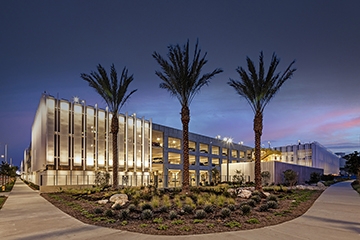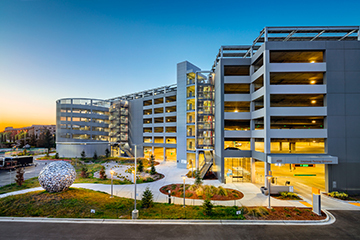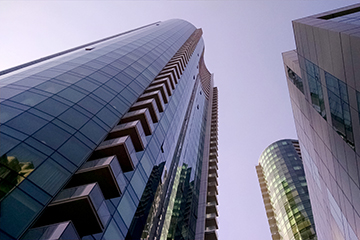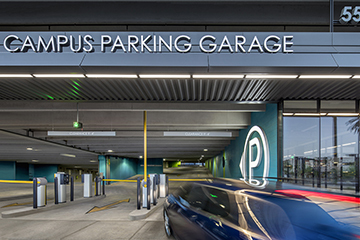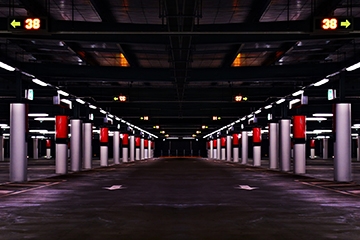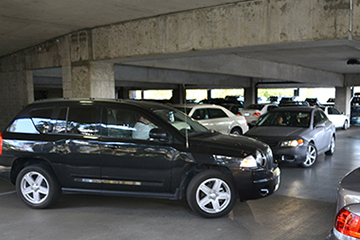Pandemic Parking Design: How COVID-19 May Affect the Future of Parking
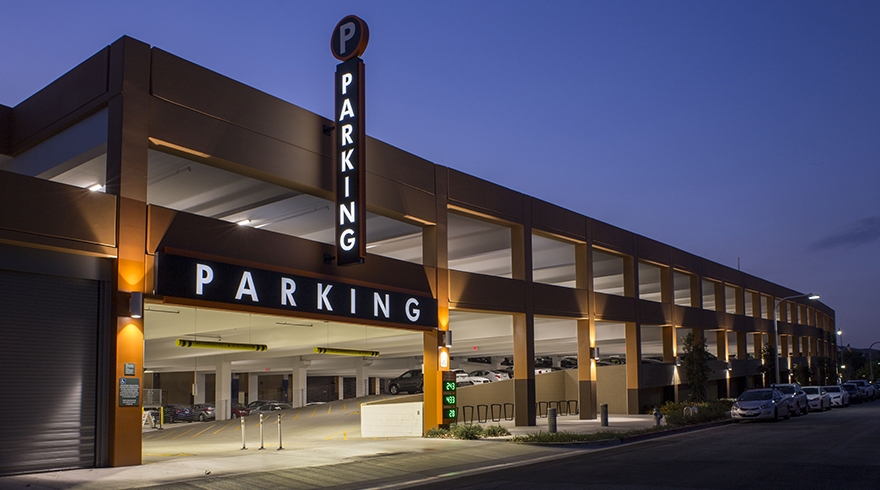
Now that we have talked about the immediate impact of COVID-19 and the value of integrating the parking arrival experience into re-opening plans, we can start to look a little farther down the road as more people return to work.
It is difficult to predict behavior changes, as even once a vaccine is widely available the lasting impacts of the pandemic are still largely unknown. Will we continue to be wary about contact with each other? Will more of the population desire to work from home versus going into the office? Will online shopping and curbside pickup continue to gain popularity? Will we return to mass transit or feel safer driving single occupancy vehicles?
The answer to each of these questions impacts parking. Therefore, it’s important to be aware of the possibilities and have our eye on how parking design might evolve as we continue working our way through this global event.
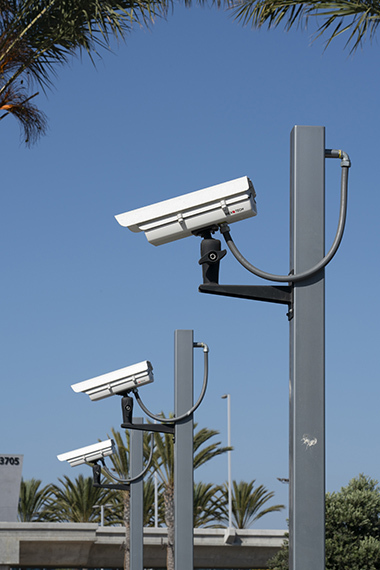 LPR and other touchless technology will likely become a standard best parking practice.
LPR and other touchless technology will likely become a standard best parking practice.
Defining the New Normal
While no one is sure what our world will look like post-COVID-19, we can all agree on one thing: we won’t be going back to normal. However, what that “new normal” will look like is difficult to predict. However, there are a number of possibilities we can consider.
High demand for touchless technology: We’re already seeing it everywhere – integrating technology that reduces contact between people and surfaces is a simple way to make parking facilities safer. Even once the immediate concerns regarding the pandemic subside, touchless technology will likely become a standard best practice.
Increased reliance on personal vehicles: Social distancing in close quarters, high contact transportation options such as mass transit or ridesharing are posing an immediate challenge for people returning to work, school and play. If this trend continues, the often predicted transition away from personal vehicle ownership in favor of alternative transportation may be slower to take place. This could result in an increase in parking demand, rather than a decrease.
Resistance to density: Will the pandemic usher in a new era of suburban renewal? In an effort to escape dense, urban centers, more people may look to the less-populated suburbs. This has potential to put even more cars on the road looking for a place to park.
Changing consumer behaviors: McKinsey and Company has reported data suggesting that consumer behavior is changing as the result of the pandemic. Among those changes is a growing trend of consumers purchasing goods online and picking them up in store. This may increase demand for convenient parking or curbside space to facilitate order pickups.
Perception is Reality
While it is too soon to know if the pandemic will have more permanent, lasting effects that call for extensive retrofits or sweeping design changes in future parking facilities, there are a number of design possibilities to consider when it comes to how consumer behavior may affect parking.
High demand for touchless technology: We’re already seeing it everywhere – integrating technology that reduces contact between people and surfaces is a simple way to make parking facilities safer. Even once the immediate concerns regarding the pandemic subside, the push to minimize contact with common surfaces like payment systems, elevator buttons and door handles will likely continue.
Parking demand: is it going up or down? COVID-19 has created massive disruptions across the board, and parking demand is no exception. However, predicting the lasting behavioral changes that may occur as a result is a challenge dependent on several factors, such as:
- Increased reliance on personal vehicles: Social distancing in close quarters, high-contact transportation options such as mass transit or ridesharing pose an immediate challenge for people returning to work, school and play. If this trend continues, the often predicted transition away from personal vehicle ownership in favor of alternative transportation may be slower to take place. This could result in an increase in parking demand, rather than a decrease.
- More work from home: The longer employees end up working from home, the more feasible this option may become long term. Employers seeking to reduce density by rotating who works in the office or encouraging workers to telecommute may offset reduced reliance on mass transit and therefore offset increased demand.
- Changes to office layouts: Employers may also look to permanently increase floor area per person to assist with social distancing. This may be both a near term impact and also a future design concept that could result in review and adjustment of required parking ratios, which will also affect parking supply and demand.
- Resistance to density: In an effort to escape dense, urban centers, more people may look to the less-populated suburbs. What impact will a new era of suburban renewal have on parking demand?
Whether none, one, or even all of these trends come to pass remains to be seen, regardless parking demand is a factor.
Changing consumer behaviors: McKinsey and Company has reported data suggesting that consumer behavior is changing as the result of the pandemic. Among those changes is a growing trend of consumers purchasing goods online and picking them up in store. This may increase demand for convenient parking or curbside space to facilitate order pickups.
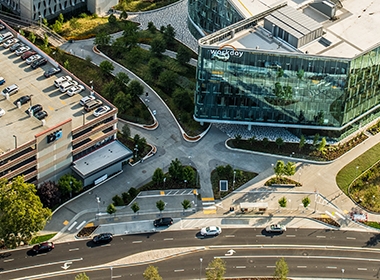 Providing designated pick up and drop off areas is already a standard best practice in parking design.
Providing designated pick up and drop off areas is already a standard best practice in parking design.
Designing for Flexibility
Many of these potential impacts on parking contradict pre-Covid trends, in which increased emphasis in mass transit and preparation for driverless cars predicted an eventual decrease in parking demand. Without knowing which way the pendulum will ultimately swing, flexibility is key for owners investing in structured parking today. Below are some options that can incorporate that flexibility into the design of a parking facility.
Go touchless: Parking access and revenue control systems that require high contact touchpoints can be phased out and replaced with touchless technology. Motion-activated ticket dispensers, LPR, Bluetooth and other forms of touchless payment are likely to become the norm. Elevators can be programmed to automatically take passengers to their destination without stopping.
Valet: Valet parking poses challenges when it comes to protecting both staff and users. If valet is necessary to meet demand, careful thought should be given to safety procedures, including how disinfecting processes affect throughput. During times of reduced demand parking it may be possible to reconfigure parking operations to reduce reliance on valet. As parking demand changes throughout the recovery period, it will be necessary to determine if and how it is in a facility’s best interest to phase this service back in. What effect, if any, the pandemic will ultimately have on valet parking remains to be seen, therefore, facilities’ approach to offering valet will largely depend on their unique and individual needs.
Expanded drop off/pick up: Providing designated pick up and drop off areas is already a standard best practice in parking design. Prior to the pandemic, rideshare companies such as Uber and Lyft increased demand for expanded drop off and pick up zones. Currently, the demand has decreased, but how it will change over time remains unknown. Whether this shift is temporary or long term, changing behaviors such as buying online and picking up in the store will also rely on sufficient accommodations for pick-up and drop-off. Combining this growing trend with an eventual resurgence of Uber and Lyft would further increase demand for curbside space. Evaluating how this best practice can best serve a particular user group will help designers incorporate it into a new facility.
Now may be a good time to review evolving parking needs and identify adjustments that can be made for changing trends, tenants, valet operators, etc. to maintain flexibility. These functional enhancements can help parking structures facing changing needs identify the most efficient way to continue providing the desired level of service.
How the COVID-19 pandemic will change the way we design for parking and mobility is not yet clear. However, by creating facilities that are smart, flexible, right-sized and mindful of the possibilities, we can better prepare ourselves to adapt to what the future ultimately holds.


